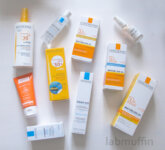I’ve posted a new video on vitamin D and sun exposure. Like most skincare addicts I’ve long thought that the sun was evil and should be avoided at all costs, but it turns out that’s an outdated viewpoint!
Vitamin D is important for pretty much everything in your body, and a lot of people are deficient in vitamin D. Does sunscreen give you a vitamin D deficiency? How can you keep your vitamin D levels up in winter without risking skin cancer and aging? In this video I talk about:
- Benefits and sources of vitamin D
- Does sunscreen give you a vitamin D deficiency?
- How much sun do you need for vitamin D?
- Health guidelines for sun exposure
- Things to keep in mind with sun exposure
It’s summer in Australia – the lights are hot and my filming room isn’t air conditioned, so please excuse my limp hair and general sweatiness! I’ve also changed my background and microphone set-up for the new year.
Check out the full video here.
The Solar D sunscreen that I mentioned is this one – it selectively lets in some wavelengths of UVB that produce vitamin D, but filters out most other wavelengths.
I use these vitamin D capsules from iHerb (they’re on Amazon too) They’re small and quite cheap – 180 softgels of 1000 IU for $6 AUD. I wouldn’t go above 1000 IU daily since taking too much can also have unpleasant side effects. I personally take one capsule a week in summer, and one every couple of days in winter, since I get some sun on most days (yay Australia), so this bottle will last me for more than a year! There’s more info on the disputed RDA on Examine.
This video is a revised version of my post Sun Protection and Vitamin D Deficiency from last last year.
References
DG Hoel, M Berwick, FR de Gruijl & MF Holick, The risks and benefits of sun exposure (open access), Dermato-Endocrinology 2016, 8, e1248325.
Position statement – Risks and benefits of sun exposure and vitamin D, Cancer Council Australia 2016.
The new guidelines on vitamin D – what you need to know, NHS Choices 2016.
D Kockott, B Herzog, J Reichrath, K Keane & MF Holick, New approach to develop optimized sunscreens that enable cutaneous vitamin D formation with minimal erythema risk (open access), PLoS One 2016, 11, e0145509.
This post contains affiliate links – if you decide to click through and support Lab Muffin financially (at no extra cost to you), thank you! For more information, see Disclosure Policy.






As someone that goes to work by bike I was never worried about getting enough sun for Vitamin D production, especially as I usually forget to apply SPF to my hands. Now I will take UV index into consideration, too.
Great video and very educational.
This is SO helpful! I live in Norway, where the days are really short in the winter, and the summers are really short (aaand I’m pretty anti-social and spend most of my time inside anyway tbh, lol), so I’m basically always lacking vitamin D. I’m taking supplements now though, but the regulations are really strict here, so I’m not sure if I’m getting enough through my supplements. I think mine are 10µ each, and recommended daily dose is 1-2 tablets. Do you think this is enough for a pale skinned girl who gets like 10 mins of sunlight per week in the winter? Haha
The jury is still out on the exact amount of vitamin D in supplements, but it seems to be around 1000-2000 IU a day according to Examine. I would supplement for a bit then get a blood test to check how well it’s working!
Insightful it is! Thanks for sharing information about vitamin D. Haven’t taken it before but i’m actually considering it now. Hoping to see more of your posts this 2018!
Thank you for the video. I know that in the Nordic countries vitamin D deficiency is very relevant. To me from Norway comes a friend often and tries to sunbathe as much as possible. And does not want to use a protective cream, wants to stock up vitamin D 🙂
It’s very difficult to work out the right balance!
Those sunglasses look so good on you 🙂 Nice post and very relevant to us here in Australia, Thankyou.
Haha thank you! They’re one of the few sunglasses that look good on me, I have a weird shaped face 😛
Depending on where you live you might not be able to convert sunlight into vitamin D for a good portion of the year. Studies vary, but in North America usually anywhere above 40′ N (about San Francisco latitude) you can’t absorb enough sunlight to manufacture vitamin D during the winter months, because the angle of the sun is too low. So it’s recommended you take a vitamin supplement or try and eat additional foods with vitamin D in them.
Hey Michelle, would you trust a sunscreen which only has Uvinul A Plus as its sole UVA filter to provide adequate UVA protection? What about a sunscreen with Tinsorb S/M as the only filters? (The sunscreens in question have a PA++++ rating by the way).
I’d trust the PA rating over the ingredients! The other ingredients in the sunscreen (the “inactives”) can make a big difference in the protection.
Hey , so going for a walking in the morning around 6-7 am required no usage of applying sunscreen right ( when the UV index is less than 3) ?